
There’s affordable accommodation and food, and more water than you’d think in Kakamas. This Orange River town is also friendly, writes Naomi Roebert.
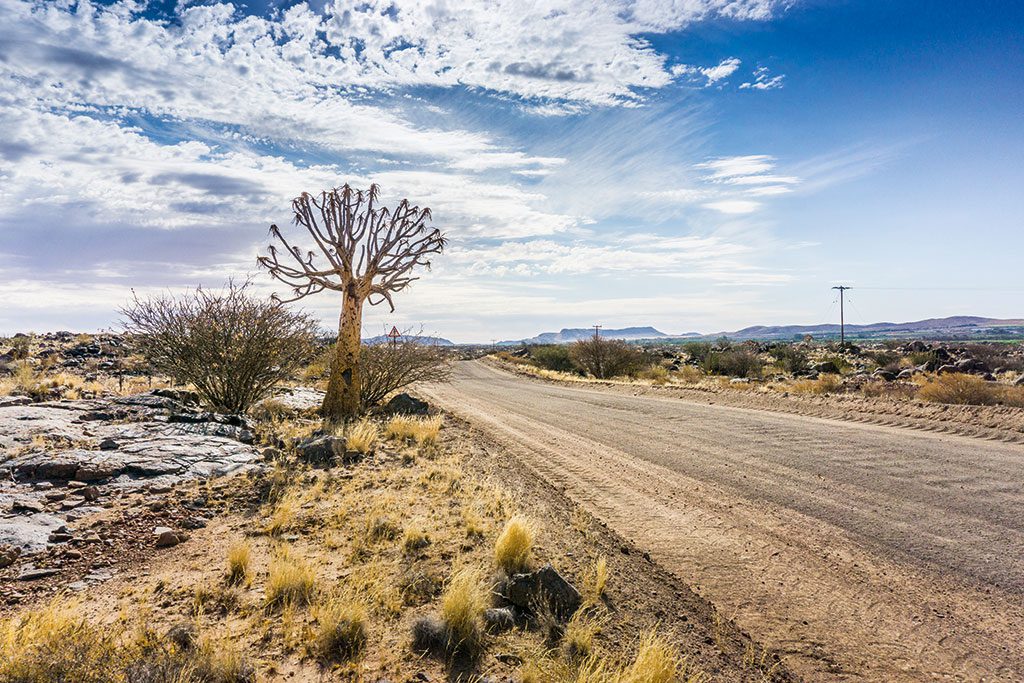
Twisting brances once used by the san to whittle quivers for their arrows now punctuate the scenic Quiver Tree Route to Kakamas.
The Insider: Wine farmer Coetzer Hanekom’s family has been farming in Kakamas for over 45 years. He showed me the beauty of this land and its water.
Coetzer Hanekom’s livelihood is inextricably linked to water, gifted from the single life-giving vein of the Orange River running through mottled tracts of the Northern Cape’s tough terrain. When I first meet him he is leaning casually against a balcony, in his white-brimmed hat, overlooking an endless banquet of Bacchus – the emerald territory of his vineyards. He is calm, friendly and kind, and as generous as the soil and water that have given him this yield.
The town of Kakamas (from the Khoi word gagamas, meaning ‘brown’, which describes the vivid red clay of this Kalahari oasis) was established as a small colony by the Dutch Reformed Church for farmers who had lost everything in the drought from 1895 to 1897. Seeking new life on the banks of the Orange River, under the raised fist of the Kalahari sun, they dragged stones across the baked ground and laid a network of canals by hand to bring the precious water home. To spare stock that had survived an outbreak of rinderpest, the farmers yoked themselves to the stones which they pulled to erect the dry-piled walls that still stand today.
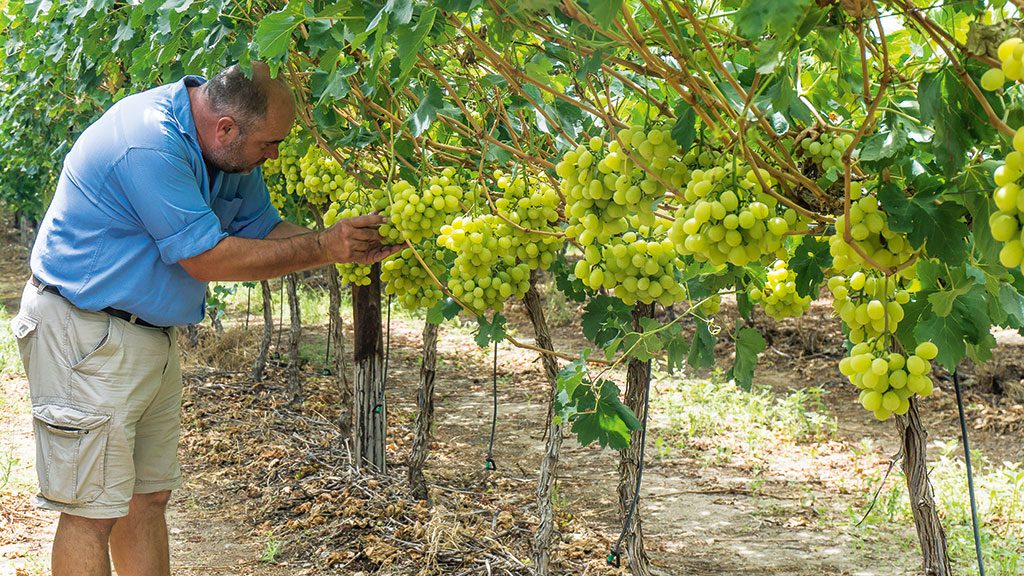
Coetzer Hanekom lovingly picking grapes from the family vines.
When I remark to Coetzer that the legacy of those first hard-working farmers seems to have been handed down through the generations, his eyes light up.
‘Yes,’ he says, ‘it’s exactly as you say.’ He disappears and quickly returns with a coffee-table book about the history of that destitute colony.
‘You can keep that,’ he smiles. Behind him the vines are heavy with bunches of grapes.
I have come to Kakamas in another time of drought, heading across the immense Northern Cape to that ‘place of big noise’ – Augrabies Falls National Park. Kakamas is just 30 kilometres from the park, and so I decided to explore this place of sudden greenery. I had arrived the night before, following the white-sand roads to the tented riverside camp where local farmers were playing beer pong under the thatched lapa perched over the river. Behind their hearty guffaws, I could hear the sighing waters roaming through the reeds. I slept soundly in a dreamless star-filled night soft with watery murmurs.
Early the next morning I headed to Die Mas wine farm, owned by Coetzer, his two brothers and their father, who started the farm in 1970 with a few hectares of grapes. Today the vines sweep across the undulating territory towards the barren mountains, yielding up to 50 tons of wine grapes per hectare.
Coetzer takes me on a tour of the land in his rumbling 4×4 to show me what man has made of the river. ‘That mountain peak over there is called Neusberg, because it looks like a nose. Behind it is a hole. Can you see it? That’s where the farmers used to hide their cattle from the church’s Commission of Enquiry.’
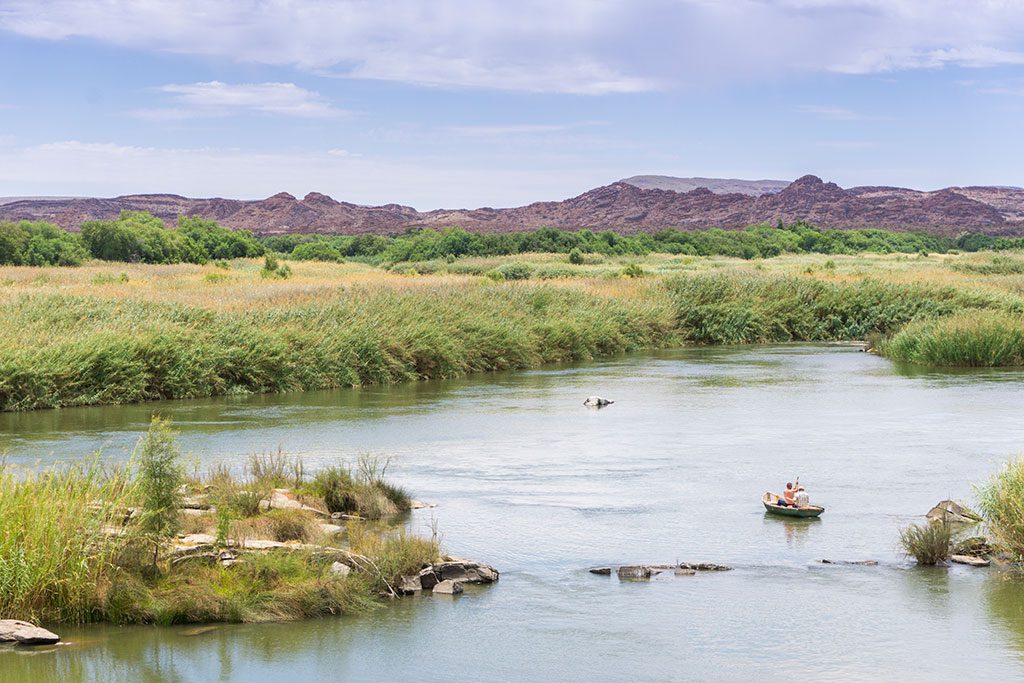
Day visitors to Kakamas drift down the Orange River.
We stop by the old waterwheels still turning in the canals. Then along dusty vineyard roads he takes me to a deep weir, cradled by mountains, and at last up the craggy mountainside to show me what the river has given man. I see an immeasurable green belt of agriculture that runs for hundreds of kilometres beside the water, flanked by arid ground. This area, sprawled along the edge of the desert, is one of the highest producers of grapes and dried fruit in the country.
Perched on a rugged slope, I notice a lone half-drum braai. ‘So what do you do for fun around here?’ I ask. ‘We all have our special secluded spot along the river where we like to braai,’ he says, gazing down the winding stretch of water.
‘We make our own entertainment.’ He looks over at his small son hopping along a rocky seam clutching a bunch of freshly picked grapes. ‘We haven’t yet lost the art of children playing together at a campsite and making new friends.’
‘And how would I get to one of those spots on the river?’ I ask.
‘Anyone will take you,’ he replies. ‘The easiest way to make friends in Kakamas is just to arrive.’
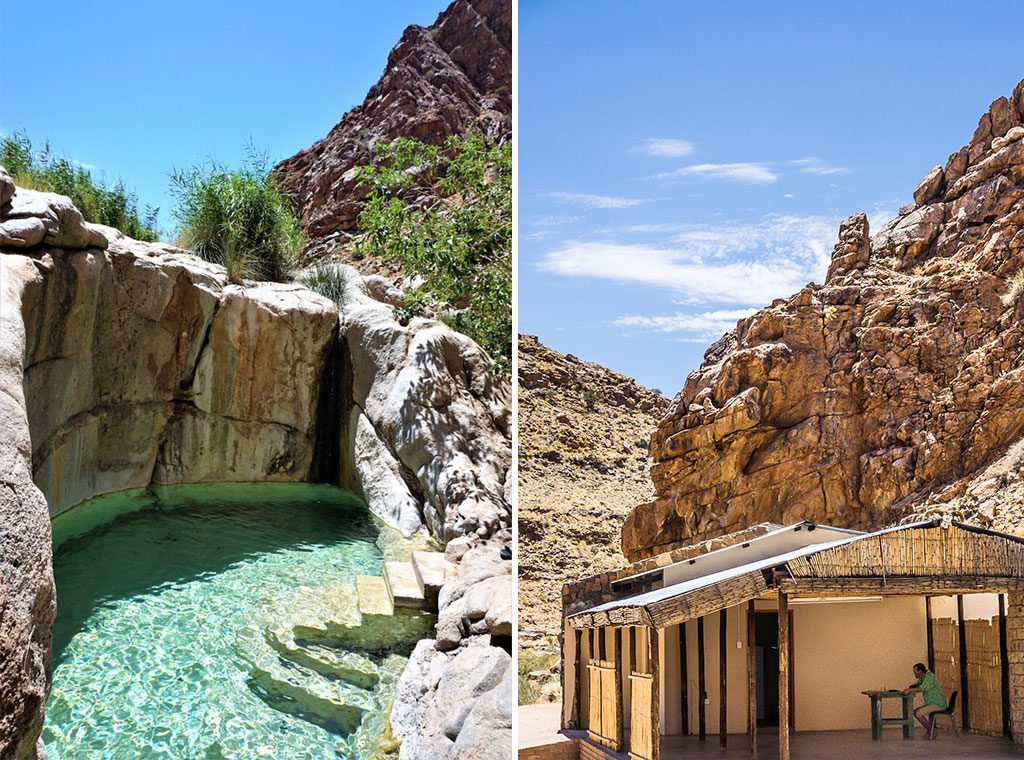
The cool blue waters of a Riemvasmaak spring in the shadows of tall granite cliffs.
Back in town, the main road is dusted with age-old quiver trees that point like suspended arrowheads at the heavy sun. I return to the campsite and collapse into an antique rocking chair overlooking the slow-bending water. As the sun lowers, a red wind rises hot from the desert. There is nothing but to jump, fully clothed, into the cool embrace of the river.
Tomorrow I will take the road to the Riemvasmaak Hot Springs, crawling down the cliff roads as though I’m tiptoeing over the shoulders of sleeping stone giants. And later, at the end of that dramatic mountain pass, the Kalahari will suddenly appear like a petrified ocean of dunes swathed in ancient and
profound silence. But for now I am simply floating down the river, blazing orange in the setting sun.
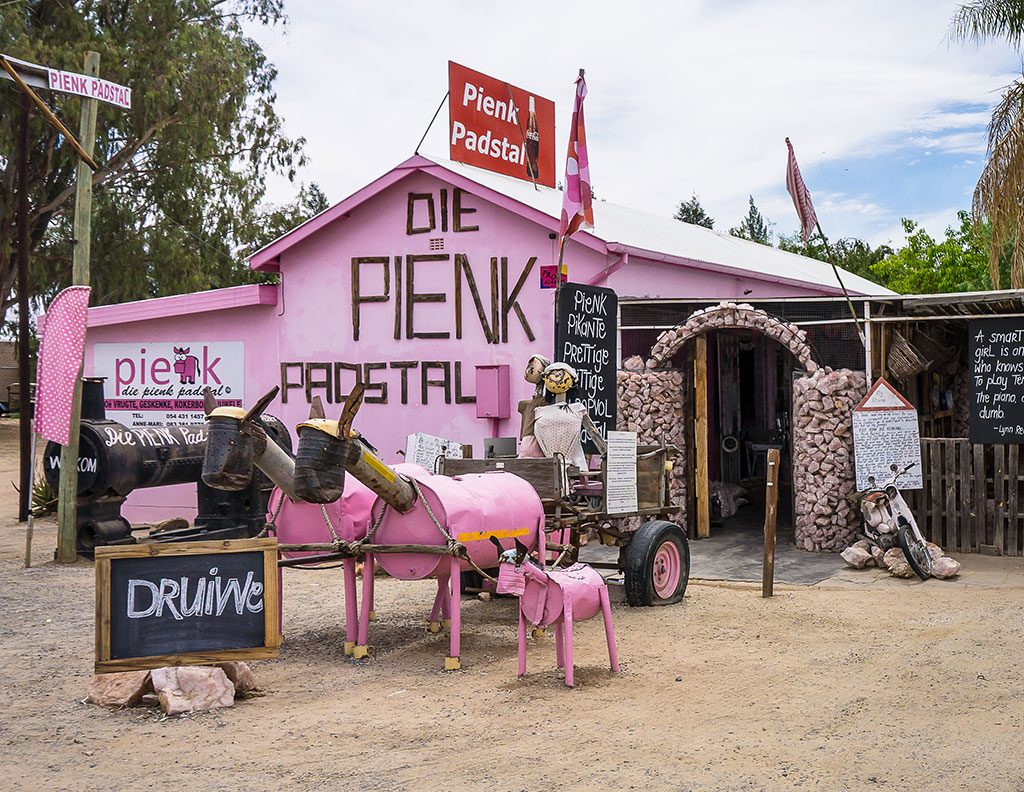
Die Pienk Padstaal in Kakamas.
Where do the locals go?
Gina Cloete, tourism manager
‘People should visit the waterwheels, as they form an important part of the history of our town.’
Andre Landman, winemaker
‘On the weekends we love to go to the lapa at Die Mas. It has a really nice crowd of younger people, all friends, having a drink, eating pizza and dancing.’ (see Do This)
Monica Vermaak, coffee-shop owner
‘Lying in Riemvasmaak Hot Springs on a summer’s evening is my favourite. Facing the mountains, you can see the shape of Africa in the rocks.’ (see Do This)
Plan your trip
Getting there
From Joburg, follow the N14 all the way to Kakamas. The trip takes about nine hours. If you’re travelling from Cape Town, it’s about eight hours. Take the N7 to Springbok, and turn onto the N14 to Kakamas.
Two scenic drives
Take your time along the Quiver Tree Route (R359) from Upington to Kakamas. It’s a splendid winding gravel road through rocky gorges and past mystical quiver trees. The road continues to Augrabies Falls National Park.
The route to Riemvasmaak Hot Springs crosses granite cliffs stabbed with quiver trees and winds down into a valley of springs. The mountain pass is best attempted with a high-clearance vehicle. For 4×4 owners, there’s a challenging alternative route.
Do this
Take a dip in the Riemvasmaak Hot Springs, which aren’t all hot (important for summer days). The first pool is, but further down the footpath is a mineral-blue, wonderfully cool spring in which to while away the hot Kalahari day, set against the backdrop of imposing mountains. R25 per person for adults, R15 per person for 16 and under. 0733838812
Taste wine at Die Mas van Kakamas and savour flavours of sun-baked terroir. Tastings are R40 per person for five different wines and R30 per person for two brandies. Bottles can be purchased at cellar rates. 0544310245.
Taste more wine at Orange River Cellars, which has one of its five wineries located in Kakamas. Tastings are R10 per person for five different wines. 0544310830
Learn how to slalom water ski at Lake Grappa, a unique man-made waterski resort built by a farmer on his land. Lessons are provided by the owner’s son, GJ Visser, a Springbok slalom skier. R450 per person for 30 minutes. 0824294811.
Visit the ‘Egyptian temple’, a historical hydroelectric plant, now a national monument, designed by an Egyptian engineer. According to some experts, the writing above the tower could be Phoenician. The plant itself was dismantled long ago and the tourism bureau (the staff are very helpful) now resides in this distinctive building. Entrance is free. 0544316300.
Browse the work of local visual artist Chris Basson, whose small gallery in the Hashvalley community exhibits thought-provoking pieces about South Africa’s history. 0717354560.
Eat here
Yanuck coffee shop is located in a lovingly tended garden on the main road, and provides tasty farmstyle breakfasts and lunches. There’s also a gift shop with souvenirs, free maps and tourist pamphlets. Meals from R20. 0544310788
Die Pienk Padstal is a quirky place you have to stop at. Its little restaurant is decorated with numerous antiques and humorous signs and sayings, and Benjamin the extremely vain cat might sidle over for a photo op. Paninis, pies, waffles and some of the best homemade apple cake are served. From R20 for a meal. There’s also a gift shop, a book corner and large bags of locally collected rose quartz for sale (R50 per 10kg). 0833819272.
Vergelegen Guest House, about three kilometres from town, has a beautiful four-star restaurant. Light lunches are served in the coffee shop which transforms into an ambient cocktail lounge at night with beautiful sundowner views of the surrounding vineyards. Lunch from R100 per person, dinner from R200 per person. 0544310976
Stay here
Kalahari River & Safari Co has self-catering tents (with beds and electricity), family huts and a campsite on the banks of the Orange River. R350 for four and R80 per person thereafter (maximum six) for a campsite stand; R800 for two sharing or R995 for four adults in a river hut; R580 for two sharing a river tent. Adventure activities on offer include 4x4ing, mountain biking and sunset game drives. From R50 per person. 0842444408.
Vergelegen Guest House has modern Cape Dutch style accommodation. From R980 for two sharing, from R1280 for a family room (sleeps three) and from R1880 for a luxury self-catering studio apartment (sleeps six). 0544310976.
* Prices correct at time of going to print
Read more from this story in the February 2017 issue of Getaway magazine.
Our February issue features a wild new way to traverse the Baviaanskloof, the Okavango Delta’s most affordable safari, 6 local shores to explore and Italy’s 8 prettiest dips.
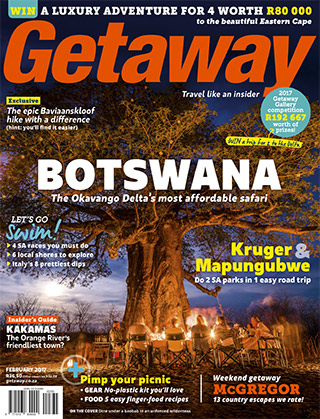
This article, The Insider’s Guide to Kakamas, was originally posted on the Getaway Blog by Getaway.